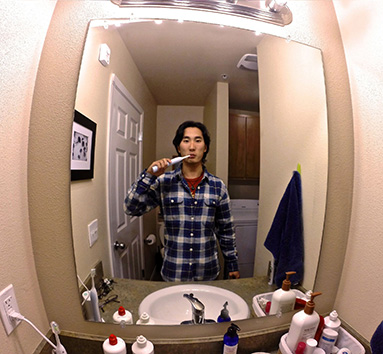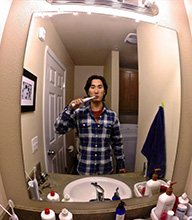
By associating itself with the selfish pleasures of visibility, the wearable camera GoPro has staved off criticism for how it enhances surveillance
In On Photography, Susan Sontag laments the disconnected voyeurism photography produces. “Photographs are a way of imprisoning reality,” she declared. Watching people stare at their phones rather than the world around them suggests that she was spot on. Capitalizing on that widely held impression, the thriving camera company GoPro sells a different view: Cameras don’t have to imprison reality; they can encourage you to engage with the world as fully as possible — all while documenting it, of course.
Since the advent of photography, we have craved cameras that let us capture our adventures and experiences without interfering in them, letting us seek the best images to become our memories. Even when cameras weighed 10 pounds, they were still marketed for their mobility and durability. GoPro, as an ultralight panoramic HD camera designed to be worn rather than pointed and operated, is in some ways the logical culmination of this desire. Its definitive feature is the ease with which it can be strapped on or mounted to surfboards, dashboards or foreheads to permit constant and thought-free filming.
But as the means for sharing images has expanded along with the means for capturing them, the expectations we have of photography have shifted. Photos no longer merely document future memories; they define present lifestyles. They circulate and establish personal identity. Engagement with an experience and documenting it are no longer competing impulses, if they ever were — instead they are simultaneous and mutually constitutive.
We navigate the world not only in first person, observing ourselves observe, but online as well, as part of networks. The platforms we view media through and who we are connected with on them are as important as what we see to making meaning from it. Cameras like GoPro are accommodating that shift, balancing the first-person view with the voyeuristic. The way GoPro situates us in the world as always at the center but always amid an implied crowd suits the massively multiplayer online game that life has become.
To understand GoPro’s success — Forbes noted that GoPro made up 21.5% of the U.S. digital-camcorder market in 2013 and that it has doubled its sales or more every year since launching in 2004 — we have to look at the photographic ecosystem from which it sprang. In 2012 Facebook users were uploading more than 300 million photos every day, and YouTube claims that every minute, 100 hours of video footage is uploaded to its site. Pew found that the number of people posting videos online doubled from 2009 to 2013, with 35% of them posting images in hopes of going viral.
The more this volume of online images increases, the more they must compete against one another for attention. To stand out among the flood of images pouring out from our screens, images increasingly must have clear social stakes. When every locale is photographed and shared a countless number of times, who is in the frame, who else has seen it, and what it suggests about their unique experience begins to matter as much as the image itself.
GoPro is designed with this shift in mind. The company's founder, Nick Woodman, recognized that consumers were buying fewer point-and-shoot cameras not only because smartphones had made them redundant but because ubiquitous connectivity also made sharing images as important as taking them. Social readiness has become paramount, and GoPro’s emphasis on a panoramic first-person image addresses that need, filling a niche neglected by ordinary smartphones, which still put a discrete frame around experience before mediating it. GoPro’s streaming self-documentation, on the other hand, suits what Nathan Jurgenson has called the Facebook Eye, the perspective on experience that sees things in terms of their social-media shareability first, and not as an afterthought. It proposes that we can best enjoy our media saturation and self-documentation when we live our “real lives” to the fullest, in a networked world where those real lives include social media. When the camera falls into the background, we can both document ourselves constantly and be fully present adventurers.
GoPro generates images that can circulate as avatars of the person who took them, foregrounding the photographer over the photograph or the frame and emphasizing the photographers’ actions — though not necessarily their aesthetics. Images taken with GoPro always reference GoPro, much as Instagram images reference themselves through their distinctive filters. The self-referencing in GoPro videos establish them as a particular genre, one whose formal properties cue audiences to pay attention to who took them without being distracted by any idiosyncratic artistic sensibility. GoPro documents performances more than environments, physical skill rather than scene. No matter what you are filming, GoPro interpolates you as the subject.
Since the camera’s wearable design promotes passive documentation, it presumably pushes users toward pursuing more interesting activities to document, even if it’s likely a largely aspirational purchase for most later adopters. As Nick Paumgarten argued in a recent New Yorker article, GoPro is essentially a lifestyle company more than a camera company. It relies on early adopters to live up to its marketing promises, at least enough to convince the larger market of nonextreme consumers that it’s possible that we too could “be a hero” and “go Pro.” Their exploits make GoPro seem an opportune investment for the once-a-year vacation surfer who wants to ensure that the evidence of their own occasional daring will stand out. It’s a consumer-aggrandizing ad approach perfected by the likes of Mountain Dew and Monster Energy. Only in GoPro’s case, the product actually creates the marketing materials.
But for GoPro to sustain its meteoric rise, the company cannot remain relegated to extreme sports for long. To continue to grow the company will have to try to expand the meaning of heroism. The cameras won’t stay on surfboards and mountain bikes for long. The company is already featuring family footage, concerts, and more on YouTube, pushing its lenses into the everyday. The founder has filmed the birth of his baby with a GoPro strapped to his head.
This expansion of GoPro into ordinary rather than extreme life may help the company’s growth potential, but it also threatens the exemption it has so far secured in the debates raging over visibility and surveillance. As GoPro tries to increase our desire to document, highlighting the self-defining pleasures of being seen, revelations about rampant online surveillance quells it. We are increasingly unsure of when we are being documented, by whom, and for what purpose, and adding more cameras to the public sphere threatens to make this worse. The NSA leaks have revealed that the most pervasive intrusions of our privacy were not from new spy tools but rather through simple access to the data we passively generated online and on digital devices. We spied on ourselves. And as the furor over Google “Glassholes” suggests, it is still easier to become outraged over other people filming us than at our own inadvertent collusion with the surveillance regime.
While Glass, which overtly trains an intrusive camera on others, remains the subject of scorn; GoPro largely escapes this by keeping the focus on capturing the perspective and extreme adventures of its owner. Browsing through GoPro videos, one rarely sees images of bystanders, the most popular videos are shot from a surfboard, inside a racecar, from a plane, with the mount focusing the lens squarely on the subject. With its “Be a Hero” tagline, GoPro relies on rugged adventurers and extreme sports to abate our privacy concerns, as if their daring would carry over and disinhibit other potential users. The new heroes of the social-surveillance age are those who would dare to be watched at all times.
